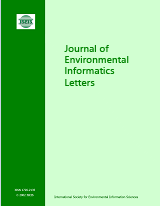Vol 13, Issue 2 (June 2025)
| Performance Analysis of Plastic Waste Management in the Informal Waste Sector: Insights from Balikpapan City, Indonesia |
PDF
|
| M. M. Harfadli, M. Ulimaz, I. Rachman, T. Matsumoto | 71-82 |
| A Mathematical Model to Unravel the Acid Rain Impact on the Growth of Plant Biomass |
PDF
SI
|
| M. Trivedi, S. Sundar, R. N. Tripathi | 83-94 |
| Effectiveness of Porous Concrete Pavements in Removing Total Suspended Solids from Urban Stormwater Runoff |
PDF
|
| D. Wijewickrama, N. Miguntanna, K. D. Siriwardhana, S. N. Kalaimathy, K. Kantamaneni, U. Rathnayake | 110-117 |
| An Equivalency Investigation of Plant’s Essential Nutrient Content in Spent Mushroom Substrate |
PDF
|
| N. Priyanka, B. S. Dayanand | 118-127 |
| Integrating Ancillary Topographic and Spectral Indices for Enhanced Glacier Terrain Classification Using the Maximum Likelihood Classifier |
PDF
|
| M. S. Meer | 128-139 |
Aims and Scope
Journal of Environmental Informatics Letters (JEIL) is an international, peer-reviewed, and interdisciplinary publication designed to foster research innovation and discovery on basic science and information technology for addressing various environmental problems. The journal aims to motivate and enhance the integration of science and technology to help develop sustainable solutions that are consensus-oriented, risk-informed, scientifically-based and cost-effective. JEIL serves researchers, educators and practitioners who are interested in theoretical and/or applied aspects of environmental science, regardless of disciplinary boundaries. The topics addressed by the journal include:
- Planning of energy, environmental and ecological management systems
- Simulation, optimization and Environmental decision support
- Environmental geomatics - GIS, RS and other spatial information technologies
- Informatics for environmental chemistry and biochemistry
- Environmental applications of functional materials
- Environmental phenomena at atomic, molecular and macromolecular scales
- Modeling of chemical, biological and environmental processes
- Modeling of biotechnological systems for enhanced pollution mitigation
- Computer graphics and visualization for environmental decision support
- Artificial intelligence and expert systems for environmental applications
- Environmental statistics and risk analysis
- Climate modeling, downscaling, impact assessment, and adaptation planning
- Other areas of environmental systems science and information technology
© 2024 ISEIS - International Society for Environmental Information Sciences
